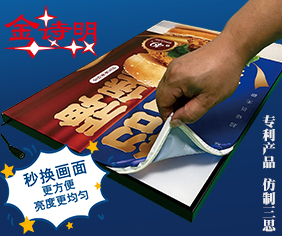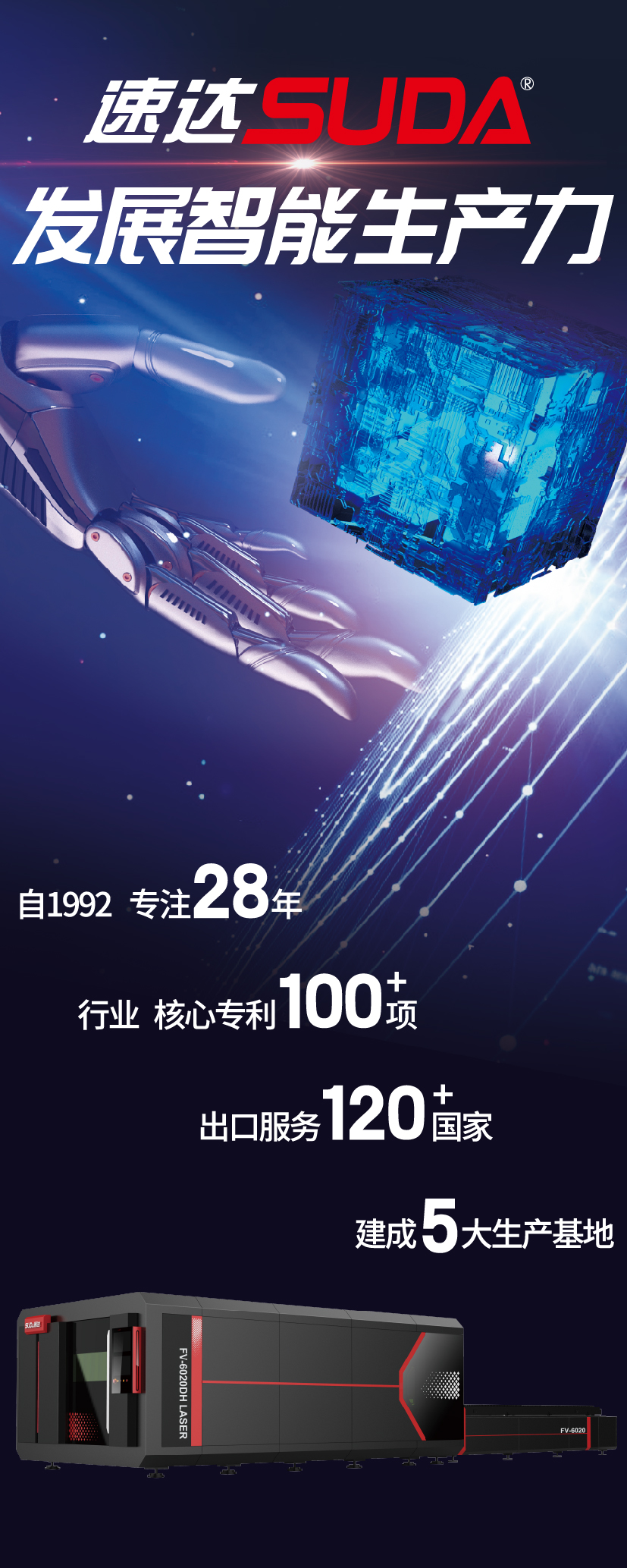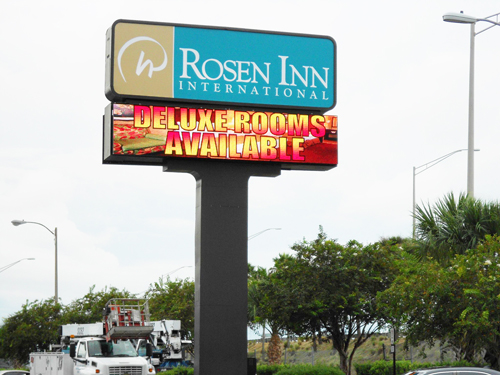
The electronic message centre (EMC) occupies a somewhat contradictory position within the sign industry. The concept of a changeable sign with some electric components has been around for about 80 years now, yet it may also seem to many sign shops like outdoor electronic displays are a new, untested technology.
电子导视牌在标识行业中占有一席之地,但是,它一直带有争议。尽管它已经存在大约80年,但似乎许多户外电子显示器的技术都未进行新的测试。
It is nearly impossible to drive through any Canadian city today without seeing EMCs as an important part of the signage mix, for example, but there are still many sign companies that have either (a) never sold an EMC or (b) sold a few but do not consider them an essential or even important part of their product offerings. The reasons for this contradiction include a combination of customer interest levels, the perceived high cost of the initial investment in an EMC, local sign ordinances’ allowance for this technology and, of course, the degree to which a given sign shop is interested in and comfortable with EMCs.
例如,如果没有将电子导视牌视为标识的重要组成部分,那么今天,几乎不可能驾车穿越加拿大的任何一个城市。但仍有许多标识制造商的业务很少涉及电子导视牌,他们不认为它们是标识产品的重要组成部分。造成这种原因包括顾客的兴趣水平,对电子导视牌初期投资的成本较高,本地法令的津贴,以及标识制造商自身的兴趣程度。
While the recent widespread adoption of EMCs could be perceived as bad news for the ‘traditional’ sign industry, it actually represents a growing opportunity for those signmakers who are interested in actively selling EMCs themselves but have not yet taken the leap into this product category.
尽管对电子导视牌的应用饱受争议,但它对于有兴趣销售电子导视牌、却尚未迈入这一产品类别的标识制造商来说,实际上是一个非常大的机会。
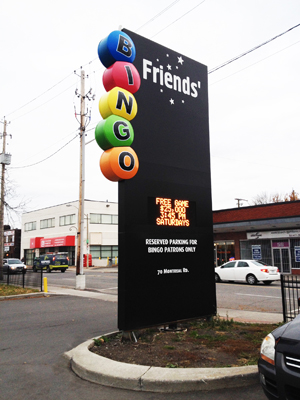
Choosing a manufacturer
如何选择制造商
That said, given today’s wide variety of manufacturers of outdoor electronic displays around the world, the decision to enter the EMC market can be a complicated one, as there are too many different brands to offer to a sign shop’s customers. It is advisable to keep the following factors in mind:
也就是说,鉴于当今世界各地有不同层次的户外电子显示屏制造商,进入EMC市场可能会非常复杂,因为有太多不同的品牌可以提供给标识制造商的客户。对此,文章总结了以下因素,供大家参考,如何才能更好地选择与出售电子导视牌:
Maturity in the industry—For how many years has a given manufacturer been specializing in building EMCs? A relatively small number of these companies have been in business for more than 10 years—and only a handful have been manufacturing displays for more than 30 years. As in any industry, choosing a ‘mature’ supplier with a strong track record can help ensure the best mix of value, robust technology and long-term customer satisfaction.
在行业中的成熟度。你将要选择的制造商是否多年来一直专注于制造电子导视牌,年限相对较少的公司已经经营了10多年,年限较多的公司已经生产了30多年。就像在任何行业一样,选择一个拥有良好业绩的成熟供应商,可以帮助确保实现最佳的价值、强大的技术,以及长期客户的满意程度。
Ease of access—The ability to meet and talk face-to-face with a manufacturer’s factory representative should never be undervalued. This person will be needed not only to support the sign shop with work in the field, but also to help both the shop and its customers if any problems arise after the sale.
易于访问。与制造商的工厂代表进行面对面交谈的能力绝不应该被低估,专业人员不仅需要支持在现场的工作,还需要在销售后出现问题时帮助解决。
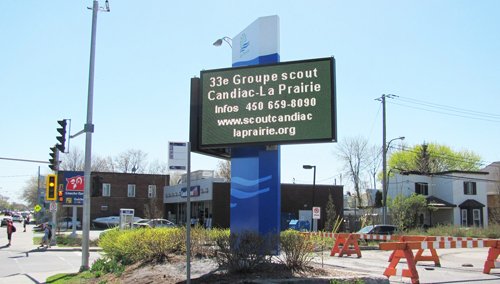
Demo support—Is there a demo unit to be placed in front of the customer? The purchase of an EMC is somewhat analogous to the purchase of a vehicle, in terms of cost and the important of making the right decision. Hence, allowing the customer an opportunity to ‘test drive’ an EMC before purchasing it should be a basic step in the sales process. It will both educate and reassure the customer.
演示支持。是否有演示单元放置在客户面前?购买电子导视牌与购买车辆方面有点类似,在购买之前,商家会让客户有机会试驾,这应该是销售过程中的一个基本步骤,这是模拟与体验的一个过程。
Software support—In addition to robust hardware, has the EMC manufacturer developed good software for controlling the sign? It is important to check and not simply assume the best. The customer will buy the hardware once, but live with the software every day, so that software needs to be intuitive and easy-to-use.
软件支持。除了强大的硬件之外,EMC制造商是否已开发出用于控制标识的良好软件? 能检查出问题,而不是简单地假设问题很重要,客户购买硬件一次就行,但每天都要与软件共存,所以软件需要直观且易于使用。
Power consumption—Even in an age of ever ‘greener’ and more sustainable technologies, buyers need to be aware of power consumption, as some brands of EMCs will use twice as much electricity as other, more efficient models.
电力消耗。即使在绿色环保可持续的时代,购买者也需要了解电力消耗的情况,因为某些品牌的电子导视牌的使用比其他更高效型号的产品花费的电力要多一倍。
Sales structure—Another aspect of the manufacturer to look into is whether or not it is a direct competitor to the sign shop. Many EMC manufacturers sell both to signmakers and to those signmakers’ customer base. A few, however, concentrate more on developing long-term relationships with individual sign companies as their authorized dealers, keeping out of the direct-to-user market.
出售结构。制造商需要考虑的另一个方面是,它是否与标识制造商有直接竞争的关系。许多EMC制造商都向标识制造商的客户群直接销售,只有少数公司更注重与个体标识公司建立长期的合作关系,作为授权经销商,避开直接面向用户的市场。
Understanding metrics
了解指标
When entering the EMC market for the first time, a sign company will need to understand the unique terminology of the industry and be able to explain it to potential customers during the sales process. Some of these terms will be key to finding the best match between a customer’s needs and what is available.
当首次进入EMC市场时,标识公司需要了解行业的独特术语,并能够在销售过程中,向潜在客户解释。其中的一些术语可作为找到客户需求的关键。
In an age when high-definition television (HDTV) has become ubiquitous, for example, new customers may well have a skewed notion as to how sharp the resolution of an outdoor display will need to be to produce a clear image. Even the most technologically advanced EMCs, however, are very low-resolution displays compared to consumer devices used inside the home. This is because all large outdoor displays use individual (often referred to as ‘discrete’) LEDs to convey full-colour photographic and video content. Generally, the arrangement of each ‘pixel’ within the display comprises one each of red, green and blue (RGB) LEDs. These pixels are the building blocks of the EMC.
例如,在高清电视(HDTV)无处不在的时代,新客户很可能会产生一个错误的观点,即室外显示器的分辨率需要达到一定的高度才能产生清晰的图像。即使是技术最先进的电子导视牌,与家庭内使用的消费类设备相比,分辨率都会低,这是由于所有大型室外显示器都使用单独(通常称为“离散”)LED来传送全彩色照片和视频内容。通常,显示器内每个像素的排列包括红色、绿色、蓝色(RGB)LED,这些像素是电子导视牌的基石。
The pixels are arranged in a matrix, the scale of which determines the EMC’s total resolution and dictates the maximum size and sharpness of the displayed images. So, rather than measuring the physical size of a display in metres or feet, an EMC is generally measured in terms of pixels. A 48 x 96 matrix, for example, offers a resolution of 4,608 pixels. The higher the total pixel count, the better the image quality.
像素以矩阵排列,其比例决定电子导视牌的总分辨率,并决定显示图像的最大尺寸和清晰度。 因此,不是以米或英尺来衡量显示器的物理尺寸,而是通常以像素来衡量。例如,48 x 96的矩阵提供4,608像素的分辨率。总像素数越高,图像质量越好。
The distance between pixels (known as ‘pitch’) also determines the clarity of the display—i.e. the closer the pixels are placed in proximity of each other, the more detailed the graphic content can be. It is common to see pixel pitches as low as 10 mm (0.4 in.) for outdoor displays today, although the industry’s current ‘bread and butter’ is in the range of 16 to 20 mm (0.6 to 0.8 in.).
像素之间的距离(称为“间距”)也决定了显示的清晰度。像素靠近放置越接近,图形内容就越详细。虽然标识行业目前的指标在16至20毫米(0.6至0.8英寸)的范围内,但户外显示器的像素间距常常低至10毫米(0.4英寸)。
The aforementioned 48 x 96-pixel matrix display, for example, with a 20-mm pitch would offer an active display area of about 0.9 x 1.8 m (3 x 6 ft). Within that same area, however, if the display were instead designed with a 10-mm pitch, the matrix could reach at least 80 x 160 pixels, for a total resolution of 12,800 instead of 4,608.
例如,前述的48×96像素矩阵显示器,具有20毫米的间距,能提供约0.9×1.8米(3×6英尺)的有效显示区域。但是,在同一区域内,如果显示器的设计间距为10毫米,矩阵可能至少能达到80 x 160的像素,总分辨率能达到12,800。
While a lower pixel pitch would therefore seem to promise a better appearance for a given image on a given display, this level of effectiveness depends on the EMC being seen by an audience beyond the minimum effective viewing distance (MEVD) of its given pitch.
虽然较低的像素间距能够在给定的显示器上,为给定图像提供更好的外观,但是,这种效果水平取决于观众在给定的最小有效观看距离(MEVD)。
Indeed, there are some guidelines to help a customer understand and choose which pixel pitch will be appropriate based on the sign’s size and location. With a closer viewing distance, a tighter pixel pitch will usually be required to ensure people see the images or graphics clearly.
另外,有一些指导方针可以帮助客户理解,并根据标识的大小和位置选择适当的观看点。随着观看距离越近,紧密的像素间距才能确保人们清楚地看清图像。
The general ‘rule of thumb’ is to multiply the pixel pitch (in millimetres) by five to determine the MEVD (in feet) for people to stand away from the display to see images clearly. With a 16-mm pitch, for example, the MEVD would be 24 m (80 ft).
一般的经验法则是将像素间距(以毫米为单位)乘以五,以确定人们与显示器保持一定的距离,以清楚地看到图像(以英尺为单位)。例如,以16毫米的间距,MEVD将为24米(80英尺)。
If an EMC is to be installed considerably high up—e.g. 12 m (40 ft) in the air—and/or well back from a roadside, the sign shop could opt for a less ‘dense’ display, as a 20-mm pixel pitch will probably be more than sufficient. If it will be installed only 3 m (10 ft) in the air, then a 12- or 16-mm pitch might be a better choice. And if it will be mounted in a parking lot where drivers will pass by closely, a 10-mm pixel pitch would be appropriate.
如果电子导视牌安装的位置比较高 ,例如,12米(40英尺)的高度,标识商店可能会选择不太密集的显示屏,因为20毫米的像素间距绰绰有余。如果将其安装在只有3米(10英尺)的高度,那么12或16毫米的像素间距是最好的选择。如果它是安装在驾驶员经过的停车场,则10毫米的像素间距是最合适的。
The next concept for the customer to understand is the viewing angle. Generally, an EMC has a horizontal viewing angle of 140 degrees and a vertical viewing angle of 70 degrees. Within the viewing area defined by these angles, the images will be seen clearly and the screen’s brightness will be 100 per cent.
客户还需要理解的一个概念是关于视角的问题。通常情况下,电子导视牌具有140度的水平视角和70度的垂直视角。在由这些角度定义的观看区域内,图像清晰可见,屏幕亮度将达到100%。
The brightness of EMCs is typically measured in terms of luminance, in candelas per square metre (cd/m2), also known as nits. Generally, monochrome EMCs provide lower luminance—in the range of 4,500 to 6,000 cd/m2—than full-colour EMCs—7,500 to 1,000 cd/m2.
电子导视牌的亮度通常以坎德拉每平方米(cd / m2)表示,也称为尼特。通常,单色电子导视牌可提供较低的亮度,范围为4,500至6,000 cd / m2,全彩色电子导视牌的范围为7,500至1,000 cd / m2。
It is very important to pay attention to luminance when selecting an EMC because the quantity of light it emits will decrease by approximately nine to 17 per cent after the first year (or roughly 10,000 hours) of operation and gradually after that. Eventually, it will tend to even off at about 50 per cent of its original total brightness after 100,000 hours of use.
在选择电子导视牌时,注意亮度非常重要,因为在第一年(或大约10,000小时)的运行后,其排放的光量将减少约9%至17%,随着使用时间还将逐渐减少,最终在使用100,000小时后,亮度将达到原始总亮度的约50%。
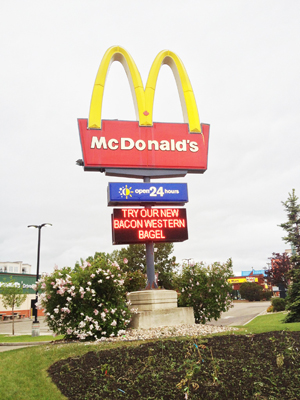
Discrete and SMD models
离散与SMD类型
There are also multiple types of EMCs on the market today, including discrete and surface-mounted diode (SMD) variations. It is relatively easy to identify a discrete display because, as mentioned earlier, it is a matrix made up of individual LEDs. In an SMD display, on the other hand, each set of RGB LEDs is contained within a package called a ‘chip.’
当今市场上有多种类型的电子导视牌,包括离散和表面贴装二极管(SMD)变体。识别离散显示器相对容易,如前所述,它是由单个LED组成的矩阵。另一方面,在SMD显示器中,每组RGB LED都包含在芯片的封装内。
For the majority of EMCs on the market, discrete LEDs have been the dominant technology, at least until very recently. SMD displays have been available for indoor use for quite some time, but only now are being commonly adopted for outdoor installations, as well.
对于市场上的大多数电子导视牌来说,离散LED一直是主流技术。SMD显示器可以在室内使用很长一段时间,但只有在室外安装时才被普遍采用。
The choice between these two options will depend on the prioritization of the factors mentioned earlier. SMD displays offer a much wider viewing angle and comparatively lower cost, for example, but are not as bright as discrete displays. The lower light power output of SMD displays is due to the smaller size of the overall chip. That said, great strides have been made in increasing the brightness of these displays in the past few years, which is helping drive their use in outdoor applications.
当然,这两种类型之间的选择取决于前面提到的几点因素。例如,SMD显示器提供更宽的视角和相对较低的成本,但不像离散显示器那样明亮,较低功率的输出是由于整个芯片的小尺寸决定。也就是说,在过去几年里,这些显示器的亮度已经取得了很大的进步,这也推动了它们在户外应用中的使用。





